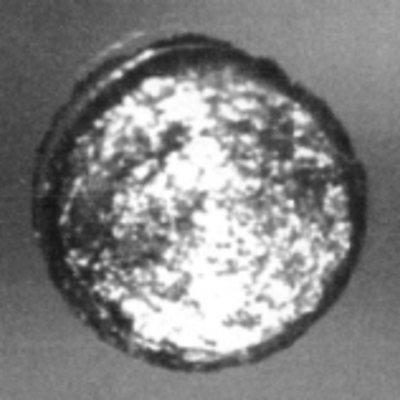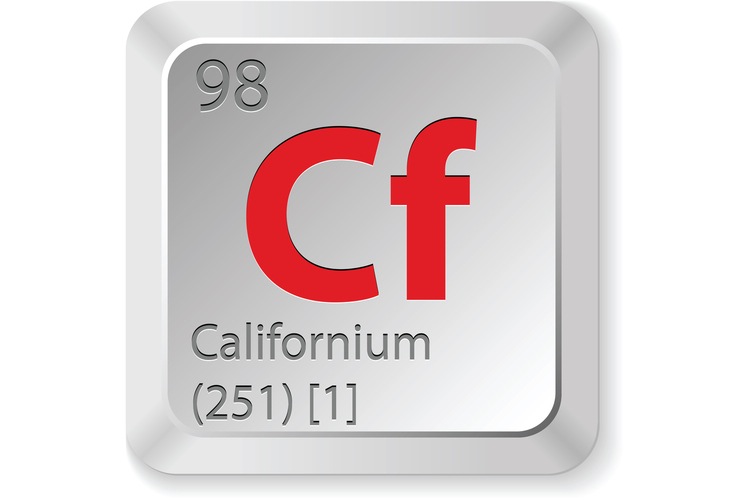Facts About Californium

Californium is a synthetic, radioactive element not found in nature. It is an actinide: one of 15 radioactive, metallic elements found at the bottom of the periodic table. The pure metal is silvery-white, malleable and so soft it can be easily sliced with a razor blade. Californium is moderately chemically reactive. It slowly tarnishes in air at room temperature — small pieces or foils of the metal begin to oxidize, but not violently.
Just the Facts
- Atomic number (number of protons in the nucleus): 98
- Atomic symbol (on the periodic table of the elements): Cf
- Atomic weight (average mass of the atom): 251
- Density: Unknown
- Phase at room temperature: Solid
- Melting point: 1,652 F (900 C)
- Boiling point: Unknown
- Number of isotopes (atoms of the same element with a different number of neutrons): 20 isotopes whose half-lives are known with mass numbers 237 to 256.
- Most common isotopes: No naturally occurring isotopes
All californium isotopes are radioactive. Cf-251 is the most stable with a half-life of about 800 years. The isotope Cf-252 is a very strong neutron emitter, meaning it has the unusual property of giving off neutrons when it breaks apart. Isotopes that behave in this way are very unusual, according to Chemistry Explained. Cf-252 is used in a variety of industries: military applications, metal detectors, and as a way to detect metal fatigue and stress in airplanes.
Discovery
In 1950, American scientists Stanley Thompson, Kenneth Street, Albert Ghiorso and Glenn Seaborg first produced californium in a lab at the University of California, Berkeley. It was the sixth synthetic transuranium ("beyond" uranium) element in the actinide group to be discovered. The discovery occurred when the chemists bombarded curium-242 with alpha particles (helium atoms without electrons) in a 60-inch cyclotron particle accelerator, according to Chemicool.com.
Each nuclear reaction created Cf-245 — an isotope with a half-life of about 45 minutes — and a free neutron. The scientists produced around 700,000 atoms of Cf-245, just enough to make a cube with sides measuring only 27 nanometers, according to Chemicool. After a chemical analysis, the scientists confirmed that a new element had been discovered.
In 1958, californium was isolated in larger quantities (1.2 micrograms) for the first time by Thompson and researcher Burris Cunningham at the Materials Testing Reactor in Idaho via prolonged (five years) neutron irradiation of plutonium-239.
Uses
Cf-252, a californium isotope with a half-life of 2.645 years, is a very strong neutron source. One microgram (0.000001 grams) of Cf-252 produces 170 million neutrons per minute, according to Jefferson Lab. This isotope has a variety of uses, including acting as a neutron emitter, providing neutrons for the start-up of nuclear reactors. It is also used as a neutron source to detect gold and silver ores through a technique known as neutron activation. It is used in neutron moisture gauges, devices that can detect water and oil-bearing layers in oil wells, according to Jefferson Lab.
The isotope Cf-252 is a target material for producing transcalifornium elements. For example, element 118, oganesson, the heaviest element, was produced when scientists bombarded californium with calcium ions, according to Chemicool. Cf-252 is also used to treat cervical cancer and can help analyze the sulfur content of petroleum.
Get the world’s most fascinating discoveries delivered straight to your inbox.
New research
There is still so much to learn about the heaviest elements in the periodic table, such as californium, berkelium and einsteinium. Thomas E. Albrecht-Schmitt, a professor of chemistry at Florida State University and his research group study the chemical and physical properties of these elements. Their research into how they bond with other elements is rewriting textbooks.
One of the first problems of studying californium, however, is actually getting a piece of it. After years of negotiating with the U.S. Department of Energy, Albrecht-Schmitt was given 5 milligrams of californium through an endowment to the university. These 5 mg have stretched through several experiments, leading to the discovery that californium has the ability to bond with and separate other materials, according to a study press release in Science Daily.
One of Albrecht-Schmitt's studies, published in the journal Nature Communications, revealed that californium is a transitional element, meaning that it helps link one part of the periodic table to the next. Specifically, californium shares properties with the three previous actinide elements in the table — americium, curium and berkelium — as well as the three actinides that come after it — einsteinium, fermium and mendelevium.
The actinides consist of 15 radioactive, metallic elements, from actinium (Ac, atomic number 89) to lawrencium (Lr, atomic number 103) in the periodic table. The heavier members are extremely unstable and do not occur naturally.
"We discovered that californium represents a place in [the] series of actinide elements (Ac to Lr) where chemistry fundamentally changes with respect to the earlier actinides," Albrecht-Schmitt told Live Science.
"Starting at californium and strengthening through einsteinium, fermium and mendelevium, and finally maximizing at nobelium, the 2+ oxidation state starts to dominate the chemistry of these elements," he explained. "For californium through mendelevium, the 2+ state is metastable, and this creates chemical and physical properties that are significantly affected by charge transfer from the ligands to the metals."
"Physicists call this 'valence instability,' and it gives rise to a host of unanticipated electronic features such as bonding changes that are more similar to transition metals than they are to lanthanides."
Albrecht-Schmitt noted that this research is important for two reasons: "First, californium is the heaviest element for which bulk chemical and physical properties can be measured," he explains. "Its electronic properties are being significantly affected by its inner electrons moving at significant factions of the speed of light. Thus, californium is a test bed for measuring how relativistic effects alter chemistry."
"Second, while these properties are less pronounced in lighter actinides like plutonium, they are still present, and can be capitalized on in separation processes that are used to recycle used nuclear fuel and help mitigate the environmental legacy of the Cold War," he said.
Who knew?
- Californium is the heaviest element that has been produced in weighable amounts.
- The spectrum of Cf-254 has been observed in supernovae.
- The Oak Ridge National Laboratory in Tennessee is the only producer of Cf-252 for the U.S. government.
- Californium is considered to be a transuranium element, meaning "beyond uranium," on the periodic table. Uranium is element number 92, so elements with atomic numbers higher than 92 are transuranium elements.
- Cf-252 is used to treat some cervical and brain cancers when radiation is ineffective.
- Only a few compounds of californium have been produced and studied, including californium oxide (CfO3), californium trichloride (CfCl3) and californium oxychloride (CfOCl).

 Live Science Plus
Live Science Plus






